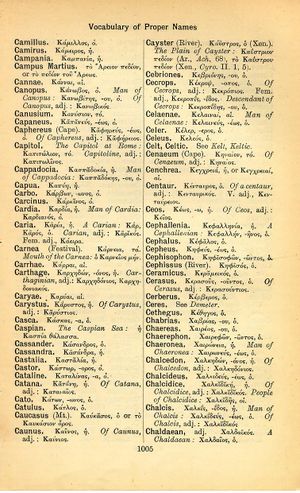Cannae: Difference between revisions
Αὐρήλιοι... πατρὶ... καὶ μητρὶ... μνήμης χάριν → The Aurelii, in memory of their father and mother (inscription from Aizonai, Phrygia)
m (Text replacement - "}}]]" to "}}]]") |
m (Text replacement - "(|thumb)\n(\|link=)" to "$1$2") |
||
| Line 1: | Line 1: | ||
{{WoodhouseENELnames | {{WoodhouseENELnames | ||
|Text=[[File:woodhouse_1005.jpg|thumb | |Text=[[File:woodhouse_1005.jpg|thumb|link={{filepath:woodhouse_1005.jpg}}]]Κάνναι, αἱ. | ||
|link={{filepath:woodhouse_1005.jpg}}]]Κάνναι, αἱ. | |||
}} | }} | ||
{{Lewis | {{Lewis | ||
Revision as of 16:45, 18 May 2020
English > Greek (Woodhouse)
Κάνναι, αἱ.
Latin > English (Lewis & Short)
Cannae: ārum, f., = Κάνναι (Κάννα, Polyb.),
I a village in Apulia, north of Canusium, famous for the victory of Hannibal over the Romans; it lay on the east side of the Aufidus (which is hence called Amnis Canna by Marcius vates ap. Liv. 25, 12, 5), now Canne, id. 22, 44, 1 sq. (Polyb. 3, 113); Flor. 2, 6, 15; Cic. Tusc. 1, 37, 89: Cannarum pugna, Liv. 23, 43, 4; Sil. 9, 10.—Appellative: Capuam Hannibali Cannas fuisse, a second Cannœ, Liv. 23, 45, 4; Flor. 2, 6, 21. —
II Deriv.: Cannensis, e, adj., of Cannœ, Cannensian: pugna, Liv. 23, 1, 1; 23, 1, 11; Prop. 3 (4), 3, 10 al.: acies, Liv. 23, 18, 13: calamitas, Cic. Brut. 3, 12: clades, Liv. 22, 50, 1; 25, 12, 5; 23, 30, 11: ruina, id. 23, 25, 3: dies, Flor. 4, 12, 35: exercitus, which was cut to pieces at Cannœ, Liv. 29, 24, 11: animae, of those who fell at Cannœ, Stat. S. 1, 4, 87.—Appel., of the proscription of Sulla: te pugna Cannensis accusatorem sat bonum fecit, Cic. Rosc. Am. 32, 89; and of a revel: Cannensis pugna nequitiae, id. Verr. 2, 5, 11, § 28; cf. Arn. 5, 38. —As subst.: Cannenses, ium, m., the inhabitants of Cannœ, Plin. 3, 11, 16, § 105.
Latin > French (Gaffiot 2016)
Cannæ,¹³ ārum, f., Cannes [village d’Apulie, célèbre par la victoire qu’Hannibal y remporta sur les Romains] : Liv. 22, 44, 1 ; Cic. Tusc. 1, 89 || -ēnsis, e, de Cannes : Cic. Br. 12 ; Liv. 23, 18, 13.
Latin > German (Georges)
Cannae, ārum, f., Flecken Apuliens an der Ostseite des Aufidus (der dah. amnis Canna heißt in der Weissagung des Marcius b. Liv. 25, 12, 5), bekannt durch die furchtbare Niederlage, die die Römer hier (216 v. Chr.) durch Hannibal erlitten, j. Canne, Liv. 22, 44 sqq. Flor. 2, 6, 15. Cic. Tusc. 1, 89: Cannarum pugna, Liv. 23, 43, 4. – appell., Capuam Hannibali Cannas fuisse, ein zweites Kannä, ebenso verderblich wie den Römern Kannä, Liv. 23, 45, 4 (angef. b. Flor. 2, 6, 21). – Dav. Cannēnsis, e, kannensisch, bei Kannä, pugna, Cic., Nep. u. Liv.: calamitas, Cic.: clades, Liv.: victoria, Liv.: exercitus, das bei K. geschlagene, Liv.: animae, die Seelen der bei K. Gefallenen, Sil.: sprichw., Cannensis pugna, angerichtetes Blutbad, Metzelei, Mord und Totschlag, v. den sullan. Proskriptionen, Cic. Rosc. Am. 89 (vgl. Arnob. 5, 38): von einem Gastmahl, non praetoris convivium, sed Cannensis pugnae nequitia, Cic. Verr. 5, 28. – Plur. subst., Cannēnsēs, ium, m., die Einw. von Kannä, die Kannenser, Plin. 3, 105.

